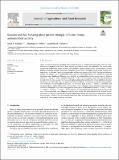| dc.description.abstract | Honey has been used in human medicine since ancient times due to its antimicrobial properties. However, honey antimicrobial potential varies due to floral sources, geographical origins, and seasonality. The current study assessed the antimicrobial activity of honey and honeybees’ preferred plants namely, Acacia mellifera, Ocimum basilicum, Hoslundia opposita, Combretum schumannii, Grewia bicolor, Terminalia brownii, Cordia monoica from Same district in Northern Tanzania, during the short and long rain seasons of 2021/2022. The agar well diffusion method was employed for the antimicrobial assay, and the antimicrobial activity was evaluated by measuring inhibition zones. Significant differences were observed in antimicrobial activities among honey of different seasons (F = 28.5, p = <0.001) and plant extracts (F = 15.9, p < 0.001). Honey A and D that were harvested at the end of the short rain season were found with higher antimicrobial activities (10–19 mm inhibition) than that harvested at the end of the long rain season (10–15 mm inhibition), and the most susceptible microorganisms were Escherichia coli and Staphylococcus aureus. For the tested plant extracts, T. brownii, C. schumannii, and H. opposita showed higher antimicrobial activities (11.3–19 mm inhibition) against pathogenic microorganisms than other tested plants. There was a strong positive correlation in antimicrobial activities (r = 0.836, p = 0.078, r = 0.756, p = 0.139, and r = 0.732 p = 0.159) between honey harvested at the end of the short rain season with some plant extracts from plants blooming during the same season. The study highlighted the variation in antimicrobial activities among honey harvested in different rain seasons and that there is antimicrobial relation between honey and plants that are foraged by honeybees. Thus, the antimicrobial ability of the honey depends much on the plant species foraged by honeybees. | en_US |

